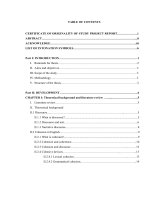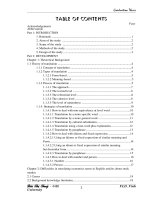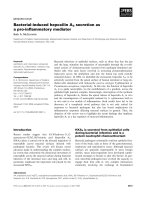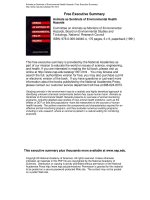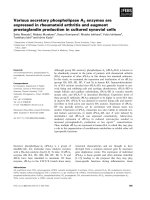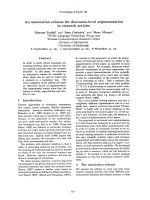Animals as Disguised Symbols in Renaissance Art
Bạn đang xem bản rút gọn của tài liệu. Xem và tải ngay bản đầy đủ của tài liệu tại đây (10.47 MB, 360 trang )
Animals as Disguised Symbols in
Renaissance Art
Brill’s Studies in
Intellectual History
General Editor
A.J. Vanderjagt, University of Groningen
Editorial Board
C.S. Celenza, Johns Hopkins University, Baltimore
M. Colish, Oberlin College
J.I. Israel, Institute for Advanced Study, Princeton
J.D. North, University of Groningen
W. Otten, University of Chicago
VOLUME 169
Brill’s Studies on Art,
Art History,
and Intellectual History
General Editor
Robert Zwijnenberg, Leiden University
VOLUME 2
LEIDEN • BOSTON
2008
Animals as
Disguised Symbols
in Renaissance Art
By
Simona Cohen
On the cover: Vittore Carpaccio, Knight in a Landscape, 1510.
Copyright Museo Tyssen-Bornemisza, Madrid.
This book is printed on acid-free paper.
Library of Congress Cataloging-in-Publication Data
Cohen, Simona.
Animals as disguised symbols in Renaissance art / by Simona Cohen.
p. cm. — (Brill’s studies in intellectual history, ISSN 0920-8607; 169)
Includes bibliographical references and index.
ISBN 978-90-04-17101-5 (hardback : alk. paper)
1. Animals in art. 2. Animals—Symbolic aspects—Europe. 3. Art,
Renaissance—Themes, motives. I. Title. II. Series.
N7660.C64 2008
704.9’43209409024—dc22
2008033692
ISSN 0920-8607
ISBN 978 90 04 17101 5
Copyright 2008 by Koninklijke Brill NV, Leiden, The Netherlands.
Koninklijke Brill NV incorporates the imprints Brill, Hotei Publishing,
IDC Publishers, Martinus Nijhoff Publishers and VSP.
All rights reserved. No part of this publication may be reproduced, translated,
stored in a retrieval system, or transmitted in any form or by any means, electronic,
mechanical, photocopying, recording or otherwise, without prior written permission
from the publisher.
Brill has made all reasonable efforts to trace all right holders to any copyrighted
material used in this work. In cases where these efforts have not been successful the
publisher welcomes communications from copyright holders, so that the appropriate
acknowledgements can be made in future editions, and to settle other permission
matters.
Authorization to photocopy items for internal or personal use is granted by
Koninklijke Brill NV provided that the appropriate fees are paid directly to
The Copyright Clearance Center, 222 Rosewood Drive, Suite 910,
Danvers, MA 01923, USA.
Fees are subject to change.
printed in the netherlands
CONTENTS
List of Illustrations ix
Acknowledgements xv
Colour Plates xvii
Introduction xxxiii
PART ONE
THE HERITAGE AND SOURCES
Chapter One. Medieval Sources of Renaissance
Animal Symbolism 3
Concealing the Tracks: The Physiologus and
Bestiary Tradition 3
A Monkey on the Roof: Animal Moralizations in
Exempla Literature and Sermons 8
Animal Moralizations in Medieval Encyclopedias 15
The Psychomachia Tradition and Images of Mounted Vices 19
Chapter Two. Renaissance Naturalists and Animal Symbolism:
Fact and Fantasy 23
Bestiaries of the Fifteenth Century: The Monsters of
Pier Candido Decembrio’s De animantium naturis 23
The Timid Hare and Lustful Camel: Leonardo da
Vinci’s Bestiary 25
Natural History in the Sixteenth Century 29
Chapter Three. Emblematic Literature and Related Sources 35
Andrea Alciato’s Emblematum Libellus: Its Sources
and Infl uence 37
The Symbola et emblemata by Joachim Camerarius 42
The Traditional and Retrospective Aspect of the
Renaissance Emblem 45
vi contents
PART TWO
CASE STUDIES
Chapter Four. The Birds and Animals of Carpaccio’s
Miles Christianus 53
The miles christianus as Metaphor 55
Aspects of Carpaccio’s Visual Language 58
Animals and Birds 59
Flowers of Virtue 83
The Problem of the Portrait 86
Car paccio’s Message 90
Chapter Five. The Enigma of Carpaccio’s Venetian Ladies 95
The Problem of Artistic Genre 95
The Precarious Legs of the Peacock 98
Cortegiane or Nobiltà? 100
The Heraldic Arms 102
Copies of Carpaccio’s Venetian Ladies 104
The History of the Kendall Copy 108
Iconographic Evidence (I): Carpaccio’s Panel 110
Animal Symbolism 112
Signifi ers and Contexts 125
Iconographic Evidence (II): The Copies 129
Reconstructing the Function of the Painting 131
Chapter Six. Animals in the Paintings of Titian: A Key to
Hidden Meanings 135
The Dog as a Symbol of Sin 136
The Stag and the Hunt 142
Moralizations of Ovid 150
Animals and Ovidian Fables 156
The Late Mythologies 158
Veronese’s Commentary 163
Chapter Seven. Titian’s London Allegory and the Three
Beasts of his Selva Oscura 165
An Allegory of Prudence? 166
Precedents in Renaissance Art 171
contents vii
The Beasts of Dante’s Inferno 176
The Mirror of Human Morals 177
Elements of the Visual Tradition 180
Titian and Moral Allegory: The Problem Defi ned 182
Titian, Sensuality and Sin 184
Titian and the Catholic Reformation 187
The Theme of Penitence in Titian’s Late Works 192
Initium Poenitentiae Cognitio Peccati 193
Chapter Eight. Animal Heads and Hybrid Creatures: The Case
of the San Lorenzo Lavabo and its Sources 195
Unresolved Issues 199
The Lavabo and Font 202
Animal Depictions and Metaphors of Sin 203
Interpreting the Animals 205
The Wolf 209
The Dog 211
The Lion 213
Other Animal Representations of Sin 218
Hybrid Creatures 221
Combined Animals/Sins: Renaissance Precedents 224
The Triad 225
Renaissance Animal-Heads 228
The Tuscan Tradition 231
The Iconography of the Lavabo 232
The San Lorenzo Lavabo and Medici Patronage 236
Chapter Nine. Andrea del Sarto’s Madonna of the Harpies and the
Human-Animal Hybrid in the Renaissance 241
Documentation of the Painting 242
Identifying the ‘Harpies’ 244
Human-Animal Hybrids 246
The Franciscans and Marian Iconography 250
Iconography for Nuns 256
Images of Eroticism and Fertility 261
Chapter Ten. The Ambivalent Scorpio in Bronzino’s
London Allegory 263
The Terrestrial and Celestial Scorpions 267
viii contents
The Medieval Scorpio 271
Scorpio in the Renaissance 276
Scorpio and Syphilis 277
Bronzino’s Satire 286
Epilogue 291
Select Bibliography 297
Index 305
LIST OF ILLUSTRATIONS
1. The Seven Deadly Sins Represented by Animals, illumination
from St. Augustine, Le cité de dieu, ca.1475–1480, Book
2, 19, KB, MMW, 10A11, fol.68v., Den Haag,
Koninklijke Bibliotheek. 11
2. Reynard the fox as a pilgrim, Illumination from Book of Hours
of Mary of Burgundy, MS.Lat.1857, f.86r, Flemish,
ca.1470–1480, Austrian National Library Vienna,
Picture Archive. 13
3. The monkey as a monk preaching to animals, illumination from
MS.133M82, fol.114r, Den Haag, Koninklijke Bibliotheek. 14
4. Lucas Cranach, St. Jerome in Penitence, 1525, Innsbruck.
Copyright Tiroler Landesmuseum Ferdinandeum. 16
5. Beaver, illumination from Jacob van Maerlant, Der Naturen
Bloeme, KB, KA 16, fol.49v, Flanders, ca.1350, Den Haag,
Koninklijke Bibliotheek. 18
6. Harpy, illumination from Jacob van Maerlant, Der Naturen
Bloeme, KB, KA 16, fol.75r, Flanders, ca.1350, Den Haag,
Koninklijke Bibliotheek. 18
7. Procession of the Mounted Sins (detail), wall painting, Chapelle
Notre-Dame-des-Grâces à Plampinet, Savoy, 1490 (Photo:
Y. Cohen). 21
8. Serra e Syrenae, Miniature from Pier Candido Decembrio, De
omnium animantium naturis atque formis, Cod. Urbinate Latino
276, fol.139r. Copyright Biblioteca Apostolica Vaticana. 25
9. Cani, engraving from Konrad Gesner, Icones animalium
quadrupedum viviparorum et ovirarorum, Zurich, 1553, p. 15.
Copyright Bibliothèque Centrale du Muséum National
d’Histoire Naturelle, Paris. 33
10. Gratiam referendam, Stork feeding its young on the rooftop,
woodcut from Andrea Alciato, Emblematum Liber, Paris,
1584 (also reproduced in Lyon, 1556; Leiden, 1591; Padua,
1621), Glasgow University Library, Department of Special
collections, Sp Coll S.M. 20, emblem 5, A3v–A4r. 41
11. Vetustate relicta, Eagle, woodcut from Joachim Camerarius,
Symbola et emblemata, Nuremberg, 1596, centuria III,
emblem no. 16, Glasgow University Library. 44
12. In secundis consistere laudibile quoque, woodcut from
Joannes Sambucus, Emblemata cum aliquot nummis,
Antwerp, 1564, Thysius 1197, p. 50.
Copyright Leiden University Library, Special Collections
Research Center. 49
13. Vittore Carpaccio, Knight in a Landscape, 1510.
Copyright Museo Thyssen-Bornemisza, Madrid. 54
14. Vittore Carpaccio, Knight in a Landscape (detail), 1510.
Copyright Museo Thyssen-Bornemisza, Madrid. 54
15. Attributed to Dürer (from the workshop of M. Wolgemut).
Creation of the Birds, Woodcut from the Nuremberg Chronicle,
1493, Library of Congress, Rare Books Division, Rosenwald
Collection, Washington D.C. 61
16. Exitus in Dubio Est, Emblem from Joachim Camerarius,
Symbolorum & Emblematum ex volatilibus et insectis desumtorum
centuria tertia, Nuremberg, 1596, Glasgow University
Library. 63
17. Heron, from Hughes de Fouilloy’s De avibus, MS.14, fol.68,
Bibliothèque Municipale, Chalon-sur-Saône. 64
18. Miles and Clericus, From Hughes de Fouilloy’s De avibus,
ca.1300, MS. Lyell 71, fol.3v.
Copyright Bodleian Library, University of Oxford. 65
19. A Knight in Emblematic Armor, from Summa de Vitiis, ca.1236,
Harl.3244, fol.28r, London, British Library. 67
20. Offi cium Natura Docet, Altdorf Medal, Epitome, Nuremberg.
Copyright Herzog August Bibliothek, Wolfenbüttel. 69
21. Superbia, from Etymachia, 1332, MS.130, fol.106, Vorau,
Stiftsbibliothek. 73
22. Ira, from Etymachia, 1332, MS.130, fol.107, Vorau,
Stiftsbibliothek. 73
23. Conversion of St. Paul, MS. Urb. Lat. 7, fol.386r (Corinthians),
13th c., Biblioteca Apostolica Vaticana. 76
24. A Monk Gathering Flowers, from Fiori de Virtù, Venice, 1493. 87
25. Hieronymus Wierix (ca.1553–1619), Miles Christianus,
engraving, Alvin 1234.
Copyright Hamburger Kunsthalle. 93
26. Thomas Cecill, Miles Christianus, engraving on verso
of title page in Joseph Fletcher, The History of the
Perfect- Cursed-Blessed Man, London, 1628. 93
27. Vittore Carpaccio, Venetian Ladies on a Balcony, ca.1495,
Venice, Museo Civico Correr. 96
28. Vittore Carpaccio, Hunting on the Lagoon, ca.1495, Los Angeles,
J. Paul Getty Museum. 96
x list of illustrations
29. Vittore Carpaccio, photographic reconstruction of Hunting
in the Lagoon, ca.1495, Los Angeles, J. Paul Getty Museum
(museum photograph). 97
30. Vittore Carpaccio, Letter Rack, reverse of Hunting in the
Lagoon, ca.1495, Los Angeles, J. Paul Getty Museum. 99
31. Anonymous copy of Vittore Carpaccio’s Venetian Ladies on a
Balcony, attributed here to the 16th c., Hollywood, Kenneth
Kendall Collection. 106
32. Vittore Carpaccio, Arrival of the English Ambassadors at the
Court of Brittany, ca.1495–6 (ex Scuola di Sant’Ursola), Venice,
Gallerie dell’Accademia. 113
33. Lucas Cranach the Elder, Cardinal Brandenburg as St. Jerome,
1526, Bequest of John Ringling, Collection of the John
and Mable Ringling Museum of Art, the State Art
Museum of Florida. 114
34. Giovanni Bellini, Altarpiece of Doge Agostino Barbarigo, 1488,
Murano, Church of San Pietro Martire, photo: Uffi cio
Beni Culturali del Patriarcato di Venezia. 116
35. Vittore Carpaccio, Annunciation, 1504 (ex Scuola degli
Albanesi ) Venice, Galleria Franchetti, Ca’ d’Oro. 118
36. Lucas Cranach, Portraits of Henry the Pious and Catherine of
Mecklenburg, 1514, Dresden, Gemäldegalerie Alte Meister,
Staatliche Kunstsammlungen. 120
37. Back of a Wooden Childbirth Tray, 15th c., Staatliche Museen
zu Berlin, Preussischer Kulturbesitz. 124
38. Margarita philosophica, Strasbourg, 1508, ‘Typus Logicae’
woodcut, Universitätsbibliothek Erlangen-Nuremberg. 126
39. Domenico Ghirlandaio, Portrait of Giovanna Tornabuoni, 1488.
Copyright Museo Thyssen-Bornemisza, Madrid. 127
40. Domenico Ghirlandaio, Visitation (detail), 1486–90, fresco,
Tornabuoni Chapel, Santa Maria Novella. 128
41. Titian, Venus of Urbino, 1538, Florence, Galleria degli
Uffi zi. Photograph: Soprintendenza Speciale per il Polo
Museale Fiorentino. 137
42. Titan, Danaë, 1553–4, Madrid.
Copyright Museo Nacional del Prado. 138
43. Titian, Crowning with Thorns, 1543, Vienna,
Kunsthistorisches Museum, Gemäldegalerie. 139
44. Titian, Flaying of Marsyas, 1570, KromÏe®íž, Archdiocesan
Museum. 140
45. The Hunt of the Frail Stag, Tapestry from series of La chasse
du cerf fragile, southern Netherlands, ca.1500–25, New York,
Metropolitan Museum of Art (Bequest of Mary Stillman
Harkness, 1950). 146
list of illustrations xi
46. The Hunt of the Frail Stag, woodcut illustration from Antonio
Fregoso’s La cerva bianca, Venice, 1521. 147
47. Titian, Venus and Adonis, 1553–4, Madrid.
Copyright Museo Nacional del Prado. 148
48. Titian, Venus and Cupid with an Organist (detail), 1548, Madrid.
Copyright Museo Nacional del Prado. 151
49. Correggio, Jupiter and Io, 1531, Vienna, Kunsthistorisches
Museum. 158
50. Titian, Pardo Venus, 1540 & 1560, Paris, Musée du Louvre,
Photo RMN. 160
51. Titian, Diana and Actaeon, after 1559, Edinburgh, Duke of
Sutherland Collection, on loan to the National Gallery of
Scotland. 160
52. Titian, Death of Actaeon, 1562.
Copyright London, National Gallery. 161
53. Veronese, Marriage at Cana (detail), 1562–3, Paris, Musée
du Louvre, Photo RMN. 162
54. Titian, Allegory, 1540s & 1570s.
Copyright London, National Gallery. 166
55. Titian, Allegory, X-ray.
Copyright London, National Gallery. 167
56. Titian, Self-Portrait, 1567–68, Madrid.
Copyright Museo Nacional del Prado. 172
57. Cristoforo Cortese, St. Francis in Glory, Paris, Musée
Marmottan, Wildenstein Collection. 173
58. Sassetta, St. Francis in Glory, ca.1437–44, Florence, Berenson
Collec tion, Reproduced by permission of the President
and Fellows of Harvard College. 175
59. Agnolo Bronzino, Justice liberating Innocence, tapestry, workshop
of Jan Rost, ca.1545, Florence, Palazzo Pitti. Photograph:
Soprintendenza per I Beni Artistici e Storici di Firenze. 176
60. Capital of the Vices, Venice, Palazzo Ducale, original 1340–55;
copied 1871–72. Author’s photograph. 182
61. Lavabo, Florence, Old Sacristy of San Lorenzo, ca.1460s–80s.
Photograph: Florence, Kunsthistorisches Institut. 196
62. Lavabo, San Lorenzo, detail of basins. Author’s photograph. 196
63. Lavabo, San Lorenzo, detail of hybrid female. Photograph:
Florence, Kunsthistorisches Institut. 197
64. Lavabo, San Lorenzo, detail of wolf’s head and Medici arms.
Author’s photograph. 197
65. Lavabo, San Lorenzo, detail of wolf ’s head. Photograph:
Florence, Kunsthistorisches Institut. 198
xii list of illustrations
66. Lavabo, San Lorenzo, detail of dog’s head. Author’s
photograph. 198
67. Capital with Heads of Wolf, Lion, Donkey and Man, 13th c.,
Pisa, Museo dell’Opera del Duomo. Author’s photograph. 207
68. Romanesque Baptismal Font with Animal Heads. Madrid,
Museo Arqueo lógico Nacional. Photograph: Archive
National Archeological museum. 209
69. Baptismal Font, detail, Pisa Baptistery, 1246. Author’s
photograph. 211
70. Baptismal Font, detail, Pisa Baptistery, 1246. Author’s
photograph. 214
71. Baptismal Font, Lucca, San Frediano, last quarter of the
12th c. Author’s photograph. 216
72. Baptismal Font, Lucca, San Frediano, detail. Author’s
photograph. 217
73. Baptismal Font, Lucca, San Frediano, detail. Author’s
photograph. 217
74. Frau Welt, Illustration from Ms. Clm 8201, fol.95R, 1414,
Munich, Bayerische Staatsbibliothek. 225
75. Dante, Divina Commedia, Inferno I, Venice (Matteo di Codeca
da Parma), 1493, woodcut. 226
76. Personifi cations of the Seven Deadly Sins and the Tree of Vices,
Venetian engraving, ca.1470–80, London, British Museum,
Department of Prints and Drawings. 229
77. Allegory of Virtue Trampling the Vices, woodcut illustration
from Fioretto de nove cose nobilissimi, Venice, 1508. 230
78. Dante, Divina Commedia, Inferno XVII, The Usurers; Descent
on Geryon, mid 15th c. miniature by Priamo della Quercia,
MS. Yates Thompson 36, 30v, London, British Museum. 235
79. Andrea del Sarto, Madonna of the Harpies, 1517, Florence,
Galleria degli Uffi zi. Photograph: Soprintendenza Speciale
per il Polo Museale Fiorentino). 242
80. Madonna of the Harpies, Photograph showing areas repainted
prior to 1983 restoration. Photograph: Soprintendenza
Speciale per il Polo Museale Fiorentino. 244
81. Engraving based on Andrea Mantegna’s drawing Virtus
Combusta, ca.1490–1500, London, British Museum. 249
82. Submovendam ignorantiam, illustration from Andrea Alciato,
Emblematum Liber, Augsburg, 1534, Glasgow University
Library, Department of Special collections, Sp Coll S.M.
20, emblem 46, C4r. 249
list of illustrations xiii
83. Giovanni della Robbia, The Immaculate Conception, ca.1515.
Glazed Terracotta Altarpiece, Church of San Lucchese
near Poggibonsi. Author’s photograph. 253
84. Detail of Giovanni della Robbia, The Immaculate Conception,
ca.1515. Author’s photograph. 253
85. Giovanni Mansueti (d.ca.1527), Madonna and Child with
Saints, early 16th c., location unknown (photograph
reproduced from Fritz Heinemann, Giovanni Bellini e
I Belliniani, 2 vols., Venezia, 1962, 633). 255
86. Giorgio Vasari, Allegory of the Immaculate Conception, ca.1543.
Copyright Ashmolean Museum, Oxford. 256
87. Francesco Bonsignori, The Blessed Osanna Andreasi, ca.1519,
Mantua, Palazzo Ducale. 258
88. Andrea del Sarto, Assumption of the Virgin, 1520s, Florence,
Palazzo Pitti, Galleria Palatina. Photograph: Soprintendenza
Speciale per il Polo Museale Fiorentino. 259
89. Chidbirth scodella, Patanazzi workshop, Faenza, 16th c.,
Maiolica, Museo Internazionale delle Ceramiche, Faenza. 260
90. Ceramic Apothecary Jar, siena, ca.1515. Musée National de
Céramique, Sèvres, Photo RMN. 260
91. Ceramic Flask, Urbino, second half of the 16th c., Florence,
Museo Nationale de Bargello. 261
92. Agnolo Bronzino, Allegory, ca.1545.
Copyright London, National Gallery. 264
93. Agnolo Bronzino, Allegory, ca.1545, detail of monster-girl.
Copyright London, National Gallery. 265
94. The Feminine Sign of Scorpio with the “virginal” Face, Tomb
Painting, ca. 2nd c., El-Salamuni, Egypt. 269
95. Andrea da Firenze, Dialectica, detail of the Liberal Arts, mid
14th c., fresco, Florence, Santa Maria Novella, Capellone
degli Spagnoli. 275
96. The Mithraic Bull-Slaying Scene, Drawing from the Mithraic
monument of Ottaviano Zeno in Rome (reproduced from
M.J. Vermaseren, Mithraic IV, Leiden, 1978, pl. XV). 277
97. Albrect Dürer, Syphilitic under the sign of Scorpio, 1496,
woodcut. Berlin, Staatliche Museum. 279
98. Removal of the Syphilitic Chancres through Cauterization,
illustration from a mid 16th century manuscript, Perugia,
Biblioteca Comunale, Augusta Ms.472. 282
99. Michelangelo Buonarroti, Tondo Doni, 1504–1505,
Florence, Galleria degli Uffi zi, photo: Soprintendenza
Speciale per il Polo Museale Fiorentino. 288
xiv list of illustrations
ACKNOWLEDGEMENTS
A special debt of gratitude is due to Benjamin Arbel, who encouraged
me to publish this book, patiently read and reread the manuscript, and
devotedly advised me along the way. My gratitude is also due to Ron
Barkai, for commenting on the manuscript, supporting me through
moments of doubt and contributing his special viewpoints.
Among the colleagues and experts who have helped me at one stage
or another of my research for this volume, I would like to mention
Mirella Levi d’Ancona, Nicholas Penny, Fiorella Gioffredi Superbi,
Kenneth Kendall, Alfi o del Serra and Edina Meyer-Maril. A special
word of appreciation is due to my former teacher Avraham Ronen,
who fi rst taught me the meaning of Renaissance scholarship. Many
thanks also to Gary Newman, who has always been there to solve my
technical problems.
Much of the research for this book was carried out at the Kunsthis-
torisches Institut in Florence, whose extraordinary library, facilities
for readers and general effi ciency, was highly appreciated. I am also
indebted to the staffs of other libraries and archives where I have
worked, including the Biblioteca Nazionale Marciana, the Biblioteca
del Museo Correr, the Archivio di Stato (ASV) and the Istituto di
Storia dell’Arte, Fondazione Cini, in Venice; the Biblioteca Medicea
Laurenziana and the Biblioteca Riccardiana in Florence; the Biblioteca
Hertziana in Rome and the Département des Arts Graphiques of the
Louvre in Paris.
Financial help for expenses entailed during periods of research abroad
was provided by my own institution, the University of Tel-Aviv, for
which I am most grateful.
Several chapters in this volume are revised versions of articles that
fi rst appeared in professional journals (see below). I wish to express my
appreciation to François Souchal, former Editor, and to Françoise de
la Moureyre, former Editorial Secretary, of the Gazette des Beaux-Arts,
for their confi dence in my work and publication of fi ve of my articles
(three of which are included here). My thanks to John Hall, Editor of
Renaissance Studies, who published three of my studies (two are listed
below) and to Michael Hall, Editor of Apollo, who was exceptionally
kind and helpful in the preparation of material for the Andrea del Sarto
article. Following is a list of the original publications:
– Chapter Four: The Birds and Animals of Carpaccio’s Miles Christianus
(published Gazette des Beaux-Arts, February 2002, 225–50).
– Chapter Five: The Enigma of Carpaccio’s Venetian Ladies (published
Renaissance Studies, vol. 19, no. 2, April 2005, 150–184).
– Chapter Six. Animals in the Paintings of Titian: A Key to Hid-
den Meanings (published Gazette des Beaux-Arts, vol. CXXXV, 1998,
193–213).
– Chapter Seven. Titian’s London Allegory and the Three Beasts of
his ‘Selva Oscura’ (published Renaissance Studies, vol. 14, no. 1, 2000,
46–69).
– Chapter Nine. Andrea del Sarto’s ‘Madonna of the Harpies’ and
the Human-Animal Hybrid in the Renaissance (published Apollo, July,
2004, 38–45).
– Chapter Ten. The Ambivalent Scorpio in Bronzino’s London Allegory
(published Gazette des Beaux-Arts, vol. CXXXV, 2000, 171–188).
There are no words to express the immeasurable debt to my family,
to my daughter Lital, who suffered through all the stages of my work
with patience and love, and to my husband Yigal, who gave me years
of moral support, understanding and sound advice. Without him this
book would not have materialized.
xvi acknowledgements
[Plate I. – Fig. 1, p. 11]
[Plate II. – Fig. 3, p. 14]
[Plate III. – Fig. 4, p. 16]
[Plate IV. – Fig. 5, p. 18; Fig. 7, p. 21]
[Plate V. – Fig. 13, p. 54]
[Plate VI. – Fig. 29, p. 97]
[Plate VII. – Fig. 31, p. 106]
[Plate VIII. – Fig. 43, p. 139]

